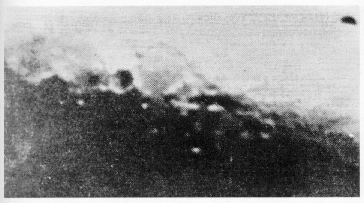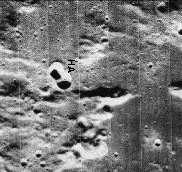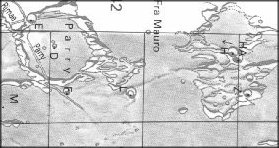

LaRRy
2larry@bluewin.ch
.
I found a picture, Lunar Orbiter IV frame H-114, as Figure 10.19, in
THE GEOLOGIC HISTORY OF THE MOON by Don E. Wilhems (U.S.G.S., Govt. Printing
Office, 1987), and the area on the RIPHEUS MOUNTAINS REGION lunar geologic
map by R. E. Eggleton (U.S.G.S., 1965).
.

 Here is part of the Rukl Chart adjacent
to Fra Mauro (42), which is Section 43 or "Lalande", the area of the
"cross". Notice the mountain range and the rest of the craters
and terrain that are at right angles. I took Bob's LO4 image and rotated
it so that both images are now aligned. The area is to the right of Parry
in the LO image. Needed is to duplicate this with a terminator
observation based on the same colongitude
in the near future. We should determine the date ASAP in order to plan this
session. - Francis Ridge (July 1, 1998)
Here is part of the Rukl Chart adjacent
to Fra Mauro (42), which is Section 43 or "Lalande", the area of the
"cross". Notice the mountain range and the rest of the craters
and terrain that are at right angles. I took Bob's LO4 image and rotated
it so that both images are now aligned. The area is to the right of Parry
in the LO image. Needed is to duplicate this with a terminator
observation based on the same colongitude
in the near future. We should determine the date ASAP in order to plan this
session. - Francis Ridge (July 1, 1998)
This would be a good project for someone to try to confirm the next time we get a third quarter Moon. Right now my ALPO Lunar Tools program is not available or I would give a schedule. Could somebody else generate one? The date was November 26, 1956, and the time must have been in the morning hours.
It should be noted, folks, that there are inaccuracies and misinterpretations in Edward's account of this picture. (Those who don't like old Uncle Bob's rumblings can skip this part):
1) It is incorrectly claimed that the four "arms" are of equal length,
although this is clearly not the case. I make the ratio of the lengths of
the two main cross elements to be 10:6. Measuring the Edwards picture
in mm's the four are: N = 4, E = 3.5, S = 6. W = 3. It's just that
at first glance, the cross is striking. In fact, when I first looked at the
picture, I thought: A plane! Then I measured the image carefully.
Also, the tips of the E and W arms are swollen and larger than the rest,
which suggests an overexposed image of the two higher areas. This overexposure
is clear from the picture, or at least the copy used in the book, which has
very high contrast, hence contains little detail near the terminator.
Edwards says on p. 202 that the film was "highly sensitized", probably Tri-X.
High speed (I mean high ISO) films are not necessary with the Moon, but of
course he was taking a movie. The photographer had the right idea,
but was just much before his time and our technology, and then had a poorly
exposed movie.
2) The ALPO's Walter Haas told SKY & TELESCOPE in 1958 that he thought
a group of ridges or mountain spurs could have been visible in this particular
form only for a fleeting period when sunlight reached the lower slopes (essentially
my point, above). Edwards claimed that this was a physical impossibility
and conflicted with nature ("according to the U.S.G.S.", he wrote) since
a ridge or mountain spur crossing another would "automatically" destroy the
other one. This may be true during the Earth's mountain-building (obviously
what the U.S.G.S. quote referred to), but on the Moon, whose forms are created
mainly by impacts, you see features overlaying other features everywhere.
Bob Young
June 28, 1998
I agree the features in the LO IV pix don't look much like a "cross",
particularly at the scale of this picture. I think the difference between
this and the 1966 Edwards pix may be due to lighting. The Lunar Orbiters
took most of their pictures, I think, from the E at about a 30 degree elevation.
In fact, as a result many steep Western features, such as deep crater walls,
etc., have little or no detail visible in the shadows. But, be that
as it
may;
The 1956 picture was taken near Sunset, and I believe the low feature making the W arm of the cross was well illuminated, as was the N-S arm, while only the peak making up the E arm was illuminated, the rest of this ridge was in shadow. This made the E and W arms seem similar. The Lunar Orbiter IV pix, on the other hand, had high E illumination, giving a good view of the E arm, and showing the W arm to be only some hillocks at about the same distance from the central ridge. I've checked the GEOLOGIC MAP OF THE RIPHEUS MOUNTAINS by Eggleton (1966). The W hillocks are less that 300 meters high, and the N-S and E arms are between 300 and 600 meters. Hard to see it, but that's the trick of light and shadow on the Moon, particularly at the terminator. This thing is, these features seem to be at the locations of the elements of the cross.
I want to enlarge the image from the Edwards pix and take a close look at it.
Bob Young
June 30, 1998